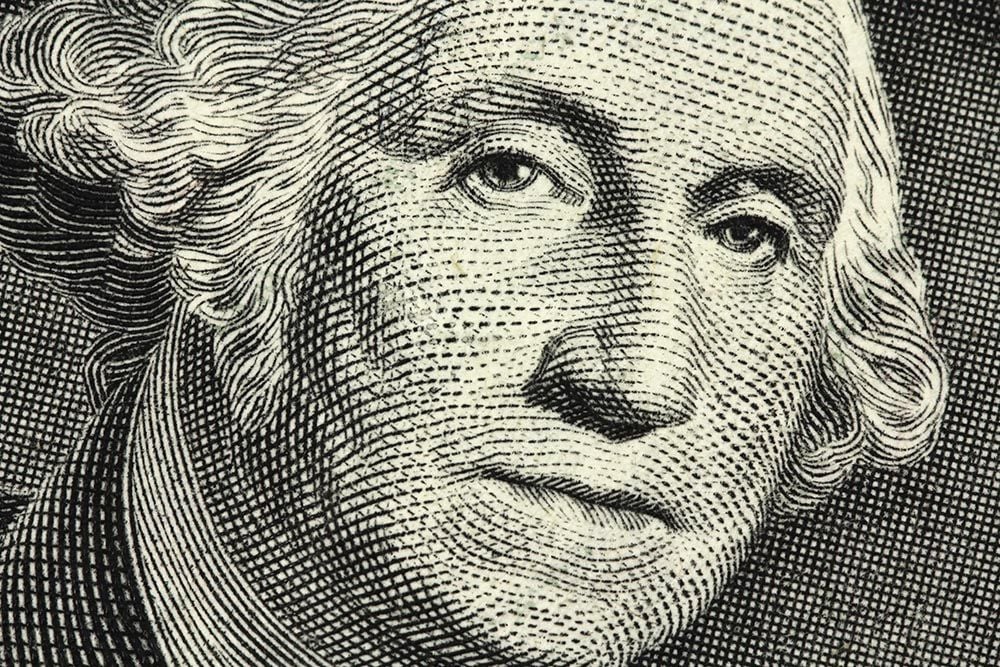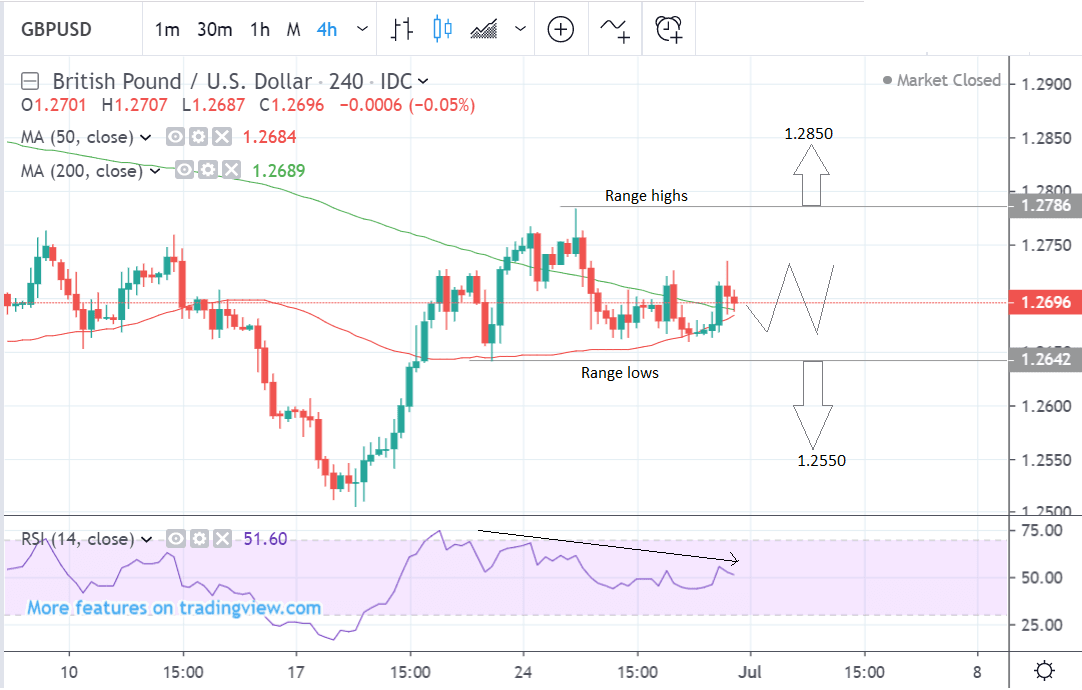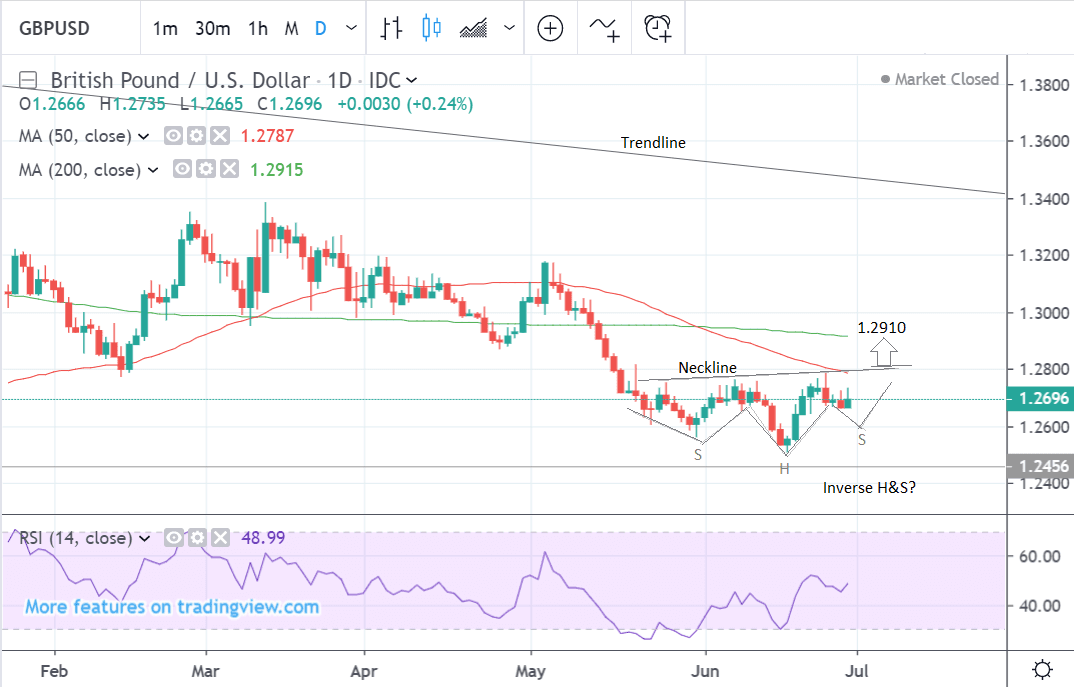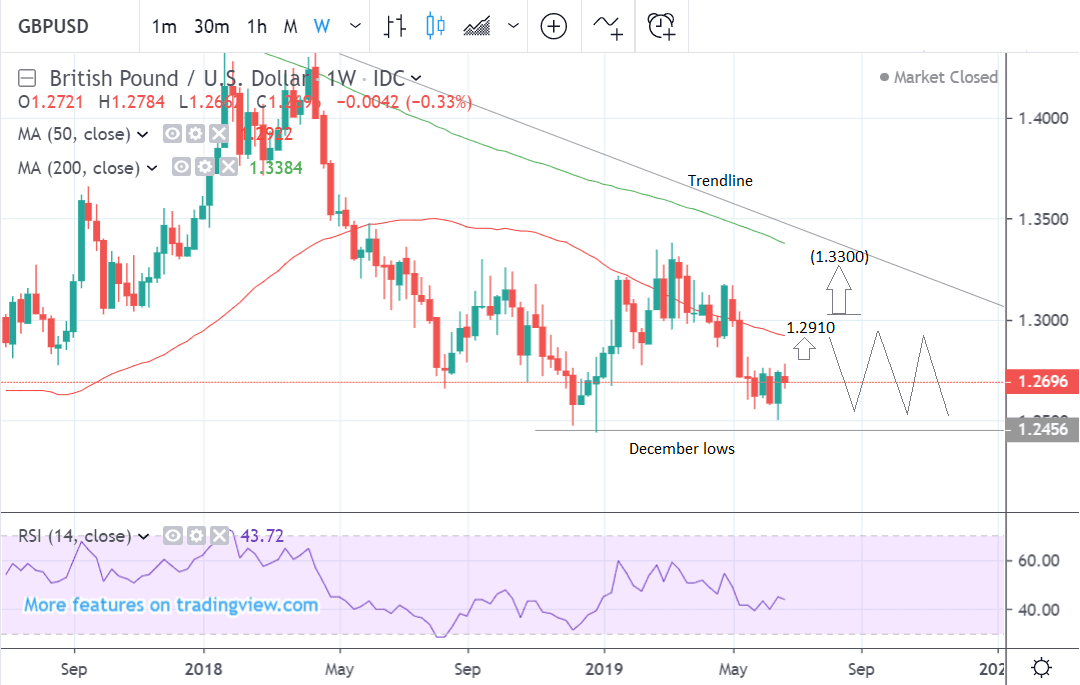Pound-to-Dollar Rate 5-Day Forecast: Range bound Short-Term, Bullish Bias Medium-Term

Image © Adobe Images
- GBP/USD in a range
- Likely to continue sideways short-term, then possibly higher
- Pound to be impacted by PMIs; Dollar by Payrolls
The GBP/USD exchange rate is trading at around 1.2696 at the start of the new week, just under half a cent lower than the previous week. Studies of the charts suggest the pair is entering a range-bound market and the exchange rate is likely to go sideways over the next five days.
The 4-hour chart shows the pair continuing to meander after rising and then falling over the last week. This sideways trend will probably continue unless the pair can break out of the range’s parameters.
If the pair can break above the 1.2790 range highs then it would confirm a breakout and continuation higher to a target at 1.2850.
Alternatively, a break below the range lows at `1.2640 would green light a continuation down to a target at 1.2550.
The RSI momentum indicator is gently declining to suggest a marginally bearish bias overall.
The 4-hr chart is used to assess the trend over the short-term, which means the next 5 days.
The daily chart shows the pair having formed a possible inverse head and shoulders reversal pattern composed of a major trough low (the head) and two shallower lows either side (the shoulders).
Such a pattern indicates a possible reversal to the upside conditional on a break above the neckline, in this case, at around 1.2815. Such a break would then provide confirmation of a break higher - with an upside target at 1.2910, just below the 200-day MA at 1.2915.
The RSI momentum indicator has risen quite strongly during the formation of the pattern and this is a bullish sign.
The daily chart is used to provide an indication of the medium-term outlook which means the next week to a month ahead.
The weekly chart is showing something of a random walk unfolding and no clearly definable trend.
If the short-term charts indicate the likelihood the pair will rise up to a target at 1.2910, the weekly gives no further clarity on the direction after that.
There is a possibility that the pair could continue rising: a break on a daily closing basis above 1.3000 would confirm a probable move up to 1.3300.
However, it is also possible the pair could continue its sideways mode over the longer-term, rising and falling between the 1.2450 December lows and the 1.2900 level.
The weekly chart is used to give an idea of the longer-term outlook, which includes the next few months.
Time to move your money? Get 3-5% more currency than your bank would offer by using the services of foreign exchange specialists at RationalFX. A specialist broker can deliver you an exchange rate closer to the real market rate, thereby saving you substantial quantities of currency. Find out more here.
* Advertisement
The Dollar: What to Watch this Week

The main release for the U.S. Dollar in the week ahead will probably be U.S. labour market statistics for June, in which the non-farm payroll release is forecast to show a 164k rise in new jobs created compared to the rather low 74k registered in May, when it is released at 13.30 BST on Friday, July 5.
If non-farm payrolls are low - by which we mean below 100k - it could lead to a fall in the U.S. Dollar as it will stoke economic slowdown fears and indicate that the U.S. Federal Reserve has reason to consider cutting interest rates over coming months. Last month's data were much lower than expected and came out at only 74k. If it registers a low reading for two months in a row it could suggest a sharper-than-anticipated slowdown on the horizon.
Average hourly earnings are forecast to rise by 3.2% and 0.3% on a yearly and monthly basis respectively in June when they are released at the same time as NFPs.
Earnings are a key metric because of their influence on inflation. In theory, when earnings rise people spend more and it drives up inflation as well as supporting growth. This leads the central bank to raise interest rates which boost the currency.
Higher interest rates increase net foreign capital inflows by making the country a more attractive destination for investors to park their capital, and this boosts demand for the currency.
Other key releases are ISM manufacturing and non-manufacturing reports, the latter of which is forecast to fall to 56.1 from 56.9 in May, when it is released at 15.00 on Wednesday, June 3. A result above 50, however, still suggests growth rather than contraction.
The reports are compiled by the Institute of Supply Managers (ISM) from surveys of their members and provide a timely insight into activity levels in different business sectors.
They are seen as a reliable leading indicator of broader economic growth and changes in the ISM often precede changes in GDP.
Another major release for the Dollar is the trade balance for May which is forecast to show the deficit widening to -53bn from -51bn previously when it is released at 13.30 on Wednesday.
A deeper trade deficit is long-term negative for the U.S. Dollar as it suggests greater demand for foreign products than for U.S. products, and therefore relatively less demand for the U.S. Dollar in order to buy them.
It also indicates lower growth since deficits are negative for growth (GDP).
A wider deficit is more likely to lead to a prolonged and broader trade war between the U.S. and its trading partners since it was the avowed intent of the current administration to narrow the deficit, which led to the current conflict with Beijing.
A ratcheting-up of trade tensions could weigh on global growth and increase risk aversion, with a complex but probably negative impact on the Dollar.
The highly anticipated meeting between Trump and Xi Xinping at the G20 conference on Saturday, June 29, resulted in a small concession from President Trump which allowed U.S. companies to sell equipment to Huawei.
Beyond that, however, there was no change to the current arrangements, although the U.S. said it would not increase tariffs on any more Chinese goods, as it had previously been threatening to.
The Pound: What to Watch this Week

The main releases for the Pound are services, manufacturing and construction PMIs for the month of June. These are surveys of purchasing managers in key sectors and come out at the start of every new month.
They provide a gauge of the level of activity and confidence in the sector. They are seen as a reliable forward indicator of economic growth.
The Manufacturing PMI is forecast to show a rise to 49.5 in June, when it is released on Monday, June 31 at 09.30 BST. This would still continue a worrying contraction in the sector since it would be below the 50 threshold, distinguishing expansion from contraction.
The Services PMI is expected to show no change at 51.0 in June when it is released at 9.30 on Wednesday.
The Construction PMI is forecast to show a rise to 49.4 from 48.6 in June when it is released at 9.30 on Tuesday.
A lower-than-expected reading would probably result in a decline in the Pound and vice versa for a higher-than-expected result.
The Conservative party leadership race is likely to have less of an impact on Sterling in the coming week.
The final vote on who will get the job will not take place until mid-July, with the new leader named on July 23. Apart from that, there is a debate on ITV on July 9.
Boris Johnson is still the bookies favourite with 1/7 (87.7%) odds according to Oddschecker. He is the 'harder' Brexiteer of the two by doggedly adhering to the October 31 deadline ‘come what may’. If his popularity should wane it would boost the Pound, but we doubt Johnson will be threatened by Jeremy Hunt.
Time to move your money? Get 3-5% more currency than your bank would offer by using the services of foreign exchange specialists at RationalFX. A specialist broker can deliver you an exchange rate closer to the real market rate, thereby saving you substantial quantities of currency. Find out more here.
* Advertisement







